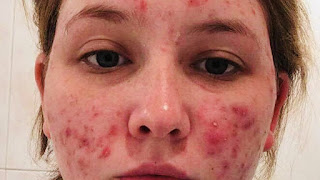Understanding Breast Cancer: Symptoms, Risk Factors, Diagnosis, Treatment, and Prevention for Women's Health
Globally, there were an estimated 20 million new cases of cancer and 10 million deaths from cancer. Living with cancer is like running away from murder, the opportunity to survive is fifty-fifty and also depends on how fast you can run. The cancer burden will increase by approximately 60% over the next two decades, further straining health systems, people, and communities.
Approximately about 1.1million new cancer cases occur in Africa, with about 700,000 deaths. most common cancers in adults include breast (16.5%), cervical (13.1%), prostate (9.4%), Colorectal (6%), and liver (4.6%) cancers, contributing to nearly half of the new cancer cases. There are several types of cancer includes, including breast cancer, prostate cancer, lung cancer, lung cancer, basal cell cancer, etc. In this article, we are going to delve into Breast Cancer.
What is breast cancer?
✰Breast cancer occurred when some breast cells begin to grow abnormally. These affected breast cells are duplicated more rapidly than healthy cells do and continue to accumulate, forming a lump or mass. Cells may spread (Metastasize) through your breast to your lymph nodes or other parts of your body. Breast cancer occurs mostly in females and slightly in males.
SYMPTOMS OF BREAST CANCER
While breast cancer may not always cause noticeable symptoms, being aware of the flowing signs can help proactive measures early.
✰ Breast Lump Or Mass: A hard, painless lump or mass in the breast or under the armpit is the most common symptom of breast cancer. However, not all breast lumps are cancerous, and benign (non-cancerous) lumps are also common.
✰ Changes In Breast Size And Shape: Breast cancer may cause the breast to appear swollen, larger, or asymmetrical. Any noticeable change in breast size or shape should be evaluated by a healthcare professional. This can cause an increase in the weight and size of your breast.
✰ Changes In The Skin: Dimpling, puckering, or redness of the skin on the breast can be a sign of breast cancer. Skin changes, such as texture or color, should not be ignored.
✰Breast Pain: while breast cancer is not usually painful, some women may experience breast pain that does not go away. Persistent breast pain should be assessed by a healthcare professional.
✰ Changes In The Nipple: Inverted nipple (pulling inward) or changes in the nipple shape or color, such as scaling or discharge, may be indicative of breast cancer and should be evaluated promptly.
NOTE: It's important to note that not all breast cancer cases present symptoms, and some breast cancers can be asymptomatic. Therefore, regular breast self-examinations, mammograms, and clinical breast examinations by healthcare professionals are crucial for early detection.
RISK FACTORS FOR BREAST CANCER
Several risk factors can increase the likelihood of developing breast cancer. These risk factors include:
✰Gender: Breast cancer occurs predominantly in women, although men can also develop breast cancer. Women need to be vigilant about breast health and seek regular screenings.
✰ Age: The risk of breast cancer increases with age. Most breast cancers are diagnosed in women over the age of 50, and age should be considered when assessing breast cancer risk.
✰ Family History: Having a close family member, such as a mother, sister, or daughter, with a history of breast cancer increases the risk of developing breast cancer. It's important to know and understand your family history and discuss it with your healthcare provider.
✰ Genetic Mutation: Inherited mutations in the BRCA1 and BRCA2 genes can significantly increase the risk of developing breast cancer. Genetic testing may be recommended for women with a family history of breast cancer or other risk factors.
✰Hormonal Factors: Hormonal factors, such as early menstruation (before age 12) or late menopause (after age 55), as well as the use of hormone replacement therapy, can increase the risk of breast cancer. Women should discuss their hormonal history with their healthcare provider.
✰Reproductive Factors: Women who have never been pregnant or have had their first pregnancy after the age of 30 are at a higher risk of breast cancer. Understanding the impact of reproductive factors on breast cancer risk is important for women's health.
✰ Lifestyle Factors: Certain lifestyle choices, such as excessive alcohol consumption, lack of physical activity, and poor diet, can increase the risk of breast cancer. Adopting a healthy lifestyle, including regular exercise, a balanced diet, and limited alcohol consumption can help reduce the risk of breast cancer.
✰Radiation Exposure: Radiation exposure, especially during childhood or adolescence, can increase the risk of developing breast cancer later in life. Women who have received radiation therapy to the chest area for other medical conditions, such as Hodgkin's lymphoma should discuss their radiation history with their healthcare provider.
✰Dense Breast Tissue: Women with dense breast tissue, as seen on mammograms, may have an increased risk of breast cancer. Dense breast tissue can make it more challenging to detect breast cancer on mammograms, and additional screening methods, such as ultrasound or MRI may be recommended for women with dense breast tissue.
BREAST CANCER DIAGNOSIS
Early detection is key to effectively ct managing breast cancer. There are several methods used for breast cancer diagnosis, including:
✰ Breast Self-Examination(BSE): Regular BSE can help women become
familiar with their breast tissue and detect any changes early on. Women should perform BSE monthly and report any changes to their healthcare provider.
✰ Clinical Breast-Examination( CBE): A clinical breast examination by a healthcare provider involves a physical examination of the breasts and underarms to detect any lumps or changes.
✰Mammography: Mammography is a low-dose X-ray of the breast tissue and is the gold standard for breast cancer screening. Women should start mammography screening at the age of 40 or as per their healthcare provider's recommendation and continue to have regular screenings based on their risk factors.
✰ Breast Ultrasound: Breast ultrasound uses sound waves to produce images of breast tissue and can help differentiate between benign and malignant breast masses.
✰ Magnetic Resonance Imaging(MRI): MRI uses magnetic fields and radio waves to create detailed images of the breast tissue and is recommended for women at higher risk of breast cancer or further evaluation of suspicious findings on mammography or ultrasound.
✰BIOPSY: A biopsy is a definitive method for breast cancer diagnosis. It involves removing a small sample of breast tissue for examination under a microscope to determine if it is
cancerous.
BREAST CANCER TREATMENT
The treatment of breast cancer depends on various factors, including the stage of cancer, the size and location of the tumor, and the overall health of the patient. The main treatment options for breast cancer include:
✰ Surgery: Surgery is a common treatment for breast cancer and may involve lumpectomy (removal of the tumor and surrounding tissue) or mastectomy (removal of the entire breast). In some cases, lymph nodes may also be removed for examination.
✰Radiation Therapy: Radiation therapy uses high-energy X-rays to kill cancer cells and is often used after surgery to destroy any remaining cancer cells in the breast or surrounding area.
✰Chemotherapy: Chemotherapy uses drugs to kill cancer cells throughout the body and may be used before surgery to shrink tumors, after surgery to destroy remaining cancer cells, or in advanced cases of breast cancer.
✰Hormone Therapy: Hormone therapy is used for breast cancers that are hormone receptor-positive, which means they are fueled by estrogen or progesterone. Hormone therapy blocks or reduces the levels of these hormones in the body to prevent cancer growth.
✰Targeted Therapy: Targeted therapy uses drugs that specifically target the cancer cells, blocking their growth and spread. Targeted therapy may be used in cases where breast cancer cells have specific genetic mutations, such as HER2-positive breast cancer.
✰ Immunotherapy: Immunotherapy uses the body's immune system to fight cancer cells. It stimulates the immune system to recognize and attack cancer cells. Immunotherapy is still being studied for its effectiveness in breast cancer treatment, and it may be used in certain cases, such as triple-negative breast cancer.
✰ Clinical Trial: Clinical trials are research studies that evaluate new treatments, therapies, or interventions for breast cancer. Participating in clinical trials can provide access to cutting-edge treatments and contribute to advancing breast cancer research.
BREAST CANCER SURVIVORSHIP
Survivorship is an important aspect of breast cancer care. After completing active treatment, many breast cancer survivors continue to receive follow-up care and support to monitor for any recurrence or late effects of treatment. Survivorship care may include regular check-ups, mammography, bone density scans, counseling for emotional well-being, and lifestyle modifications to reduce the risk of recurrence. Support groups, counseling, and other resources can also provide emotional and psychological support to breast cancer survivors.
In conclusion, breast cancer is a complex disease that affects millions of women worldwide. Early detection, through regular screening and awareness of risk factors, is crucial for improving outcomes. Understanding the different stages, types, and treatment options for breast cancer can empower women to make informed decisions about their health. It is important to have open and honest discussions with healthcare providers, seek support from loved ones, and stay informed about the latest advancements in breast cancer research. By taking steps towards prevention, early detection, and appropriate treatment, we can work towards reducing the impact of breast cancer on individuals and communities as a whole. Stay proactive, informed, and empowered in the fight against breast cancer.















Comments
Post a Comment